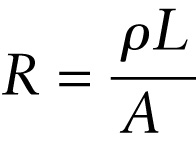Definition of resistance (18-8)
Question 1 of 4
Question
Resistance of a wire
{"title":"Resistance of a wire","description":"Correct!","type":"correct","color":"#99CCFF","code":"[{\"shape\":\"poly\",\"coords\":\"82,133\"},{\"shape\":\"rect\",\"coords\":\"10,16,12,16\"},{\"shape\":\"poly\",\"coords\":\"144,22\"},{\"shape\":\"rect\",\"coords\":\"2,49,41,101\"}]"} {"title":"Resistivity of the material of which the wire is made","description":"Wrong","type":"incorrect","color":"#ffcc00","code":"[{\"shape\":\"rect\",\"coords\":\"117,22,150,64\"}]"} {"title":"Length of the wire","description":"Incorrect","type":"incorrect","color":"#00ff00","code":"[{\"shape\":\"rect\",\"coords\":\"153,5,190,56\"}]"} {"title":"Cross-sectional area of the wire","description":"Incorrect","type":"incorrect","color":"#000080","code":"[{\"shape\":\"rect\",\"coords\":\"120,91,164,138\"}]"}Review
Equation 18-8 tells us that the resistance of a wire depends on the resistivity of the material of which the wire is made, the length of the wire, and the crosssectional area of the wire. For a given material, the resistance is greater for a wire that is long (large \(L\)) and thin (small \(A\)) than for a wire that is short (small \(L\)) and thick (large \(A\)).

